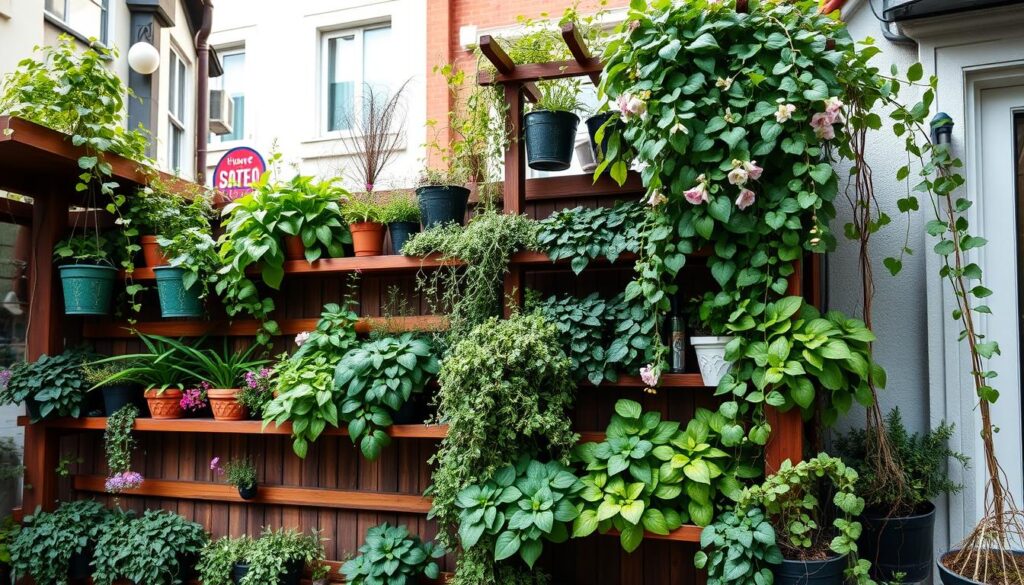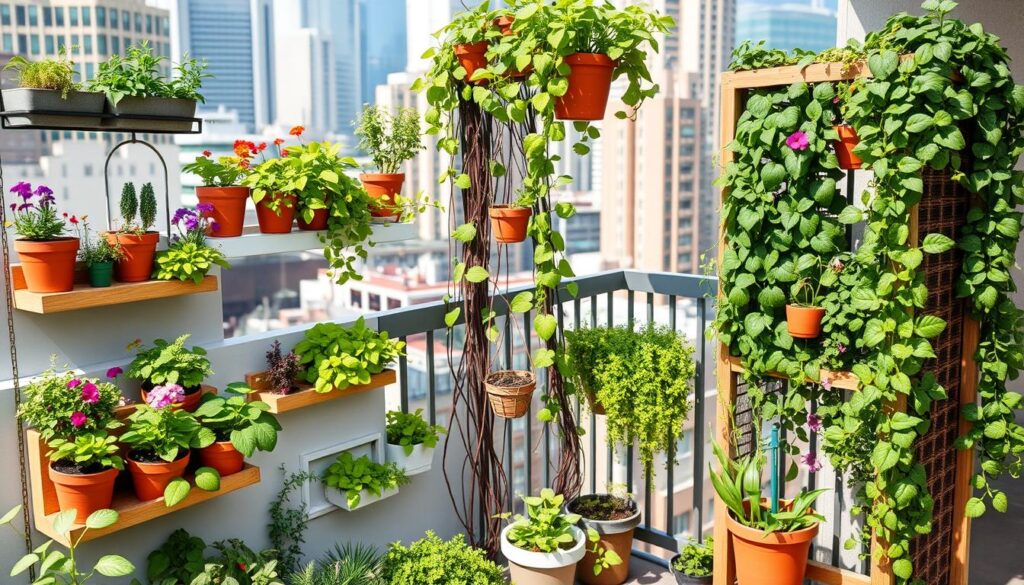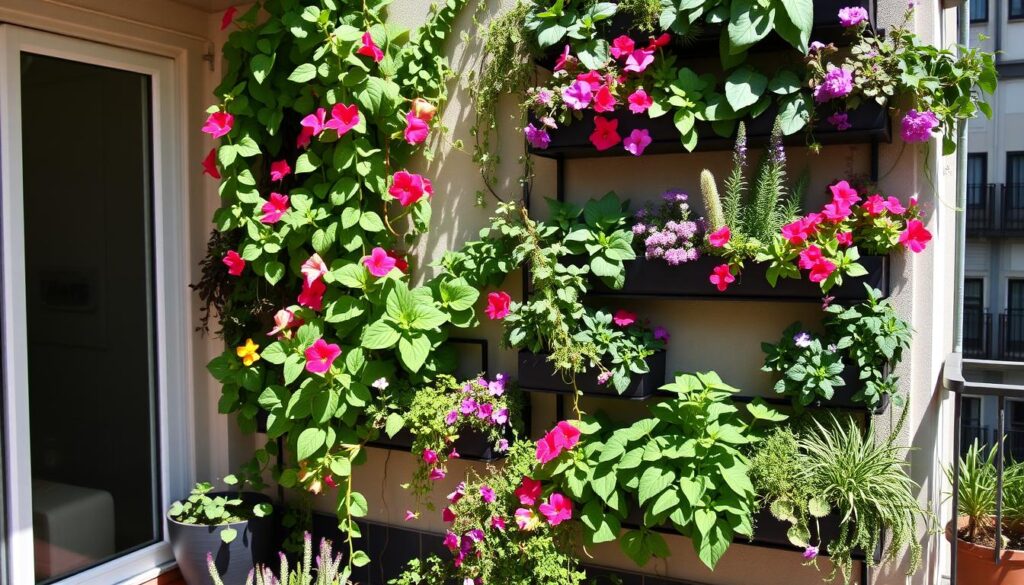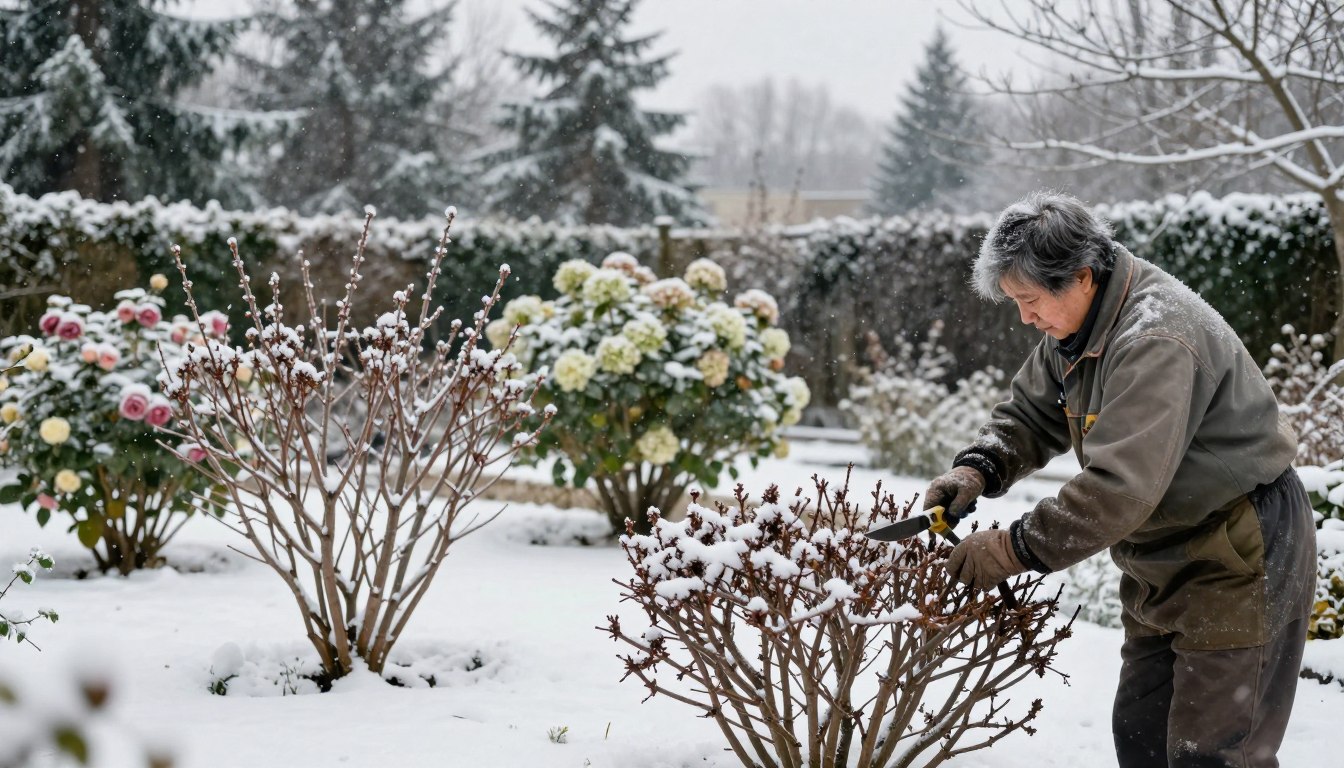In today’s world, living spaces are getting smaller. This makes growing a garden seem hard. But, vertical gardening can turn even the tiniest areas into green oases. This article will show you how to make the most of vertical space for a lively garden, even in small areas.
Key Takeaways
- Vertical gardening saves space by growing plants up instead of out.
- Using trellises, arbors, and frames can expand your growing area.
- Container gardening is great for vertical spaces, letting you grow many plants in a small area.
- Picking the right plants, like vining veggies and trailing flowers, boosts your harvest.
- Good care, like watering, fertilizing, and pruning, is key for a healthy vertical garden.
What is Vertical Gardening?
Vertical gardening is a smart way to grow plants in small spaces. Instead of spreading out, plants climb up on trellises, arbors, and frames. This method is perfect for city gardens, apartments, and anyone with little room.
Definition and Benefits
Vertical gardening means growing plants up, using supports for climbing plants. It saves space and has many benefits:
- More plants in less space: You can grow more in a small area, making your garden more productive.
- Better air flow and less disease: Plants are off the ground, which helps air move and keeps diseases away.
- Looks great: Vertical gardens make any space look beautiful and green.
- Works everywhere: You can use vertical gardening on balconies, rooftops, and even indoors.
Vertical gardening is great for anyone with limited space. It’s perfect for city gardens, apartments, and small outdoor areas. It lets you grow a lot in a little space.
Vertical Gardening Structures
Gardeners with limited space can use vertical gardening structures. These solutions help grow more plants in less space. They’re perfect for urban areas, patios, and balconies. Let’s explore trellises, arbors, and freestanding frames for garden design and intensive gardening methods.
Trellises, Arbors, and Freestanding Frames
Trellises are frames for plants to climb on. They can be attached to walls or stand alone. Arbors and archways also work as vertical gardens, with sides for plants and hooks for baskets.
Freestanding vertical frames and raised beds are flexible. They fit your space perfectly, ideal for rooftop gardening or intensive planting.
| Vertical Gardening Structure | Key Features | Best Suited for |
|---|---|---|
| Trellises | Frames made of wood, plastic, wire, or metal that can be attached to walls or used freestanding | Supporting climbing or vining plants, maximizing space-saving gardening techniques |
| Arbors and Archways | Structures with sides that can be used as a trellis, and hooks for hanging baskets | Adding vertical interest and functionality to small gardens or patios |
| Freestanding Vertical Frames | Customizable frames that can be positioned to suit your specific layout | Versatile solution for rooftop gardening or intensive planting areas |
Using these vertical structures, you can make the most of your space. Your garden will be both beautiful and productive.

Container Gardening for Vertical Spaces
If you’re short on garden space, container gardening is a great solution. It uses vertical space well. You can turn small balconies or patios into lush gardens with the right techniques.
Elevated container gardening is perfect for small spaces. Window boxes, planters on railings, and stackable planters save floor space. They’re great for indoor gardening, balcony gardens, and raised bed gardens.
Hanging containers are another space-saving choice. They hang from walls, fences, or arbors. They’re ideal for plants that cascade or trail, making the most of your vertical space.
- Elevated containers, such as window boxes or railing-mounted planters, add extra growing space without taking up floor space.
- Hanging containers suspended from walls, fences, or arbors are a space-efficient vertical gardening option.
- Stackable planters allow you to create a movable, space-saving vertical garden.
Container gardening works well for small balconies, patios, or indoor windowsill gardens. It helps you make the most of your space. You can create a beautiful garden, even in tight spots.
Maximizing Vertical Space: How to Grow a Garden in Small Areas
Gardening in small spaces is possible with vertical gardening. It uses creative techniques and structures. This way, even a balcony, patio, or indoor area can become a lush garden.
Trellises are great for vertical gardening. They support climbing plants like tomatoes and cucumbers. This saves space on the ground.
Raised bed gardens and hydroponic systems are also good. Raised beds use floor space well. Hydroponics can turn walls and ceilings into gardens.
Stackable planters and hanging baskets are perfect for container gardening. They let you grow many plants in a small area. This includes herbs, greens, and compact veggies.
“With a little creativity and the right vertical gardening techniques, even the tiniest of spaces can be transformed into a lush, bountiful oasis.”
Using these vertical gardening methods, small spaces can become beautiful gardens. They can be productive and stunning, despite their size.

Best Plants for Vertical Gardening
Not all plants are good for vertical gardening. But, many popular ones do well when grown up. They can turn a small space into a lush, productive oasis.
Climbing or vining plants like tomatoes, cucumbers, pole beans, peas, and some squash and pumpkins are great. They grow up naturally, perfect for trellises and arbors.
Peppers, lettuce, strawberries, and most herbs also work well vertically. And don’t forget flowers, ferns, succulents, and ivy. They add color and texture to your garden.
| Best Plants for Vertical Gardening | Type |
|---|---|
| Tomatoes | Climbing/Vining |
| Cucumbers | Climbing/Vining |
| Pole Beans | Climbing/Vining |
| Peas | Climbing/Vining |
| Peppers | Container |
| Lettuce | Container |
| Strawberries | Container |
| Herbs | Container |
| Flowers | Ornamental |
| Ferns | Ornamental |
| Succulents | Ornamental |
| Ivy | Ornamental |
Choosing the right plants for your vertical garden is key. It lets you use your space well and enjoy a harvest or a beautiful display. Remember, good support and growing conditions are also important.

Caring for a Vertical Garden
Keeping a vertical garden healthy needs extra care. The plants’ unique setup requires special attention to watering, fertilizing, and upkeep.
Watering and Fertilizing
Vertical gardens dry out quickly, so they need regular water. A water wand helps reach hanging plants. It’s also important to use the right fertilizer for each plant type.
Grouping plants by their water and food needs makes care easier.
Maintaining Vertical Structure
Using pot feet, casters, or stands helps move and rotate plants. This ensures they get enough sunlight. For tall or heavy plants, stakes or cages are needed to keep them upright.
As plants grow, you might need to adjust their supports. This keeps your garden looking great all season.
| Vertical Gardening Maintenance | Description |
|---|---|
| Watering | Vertical gardens dry out faster, requiring more frequent watering. Use a water wand for hard-to-reach areas. |
| Fertilizing | Tailor fertilizer formulas to the specific needs of your plants, such as leafy greens, fruits, or flowers. |
| Pot Feet, Casters, and Stands | These accessories make it easier to move and rotate plants for even sun exposure. |
| Staking, Caging, and Supports | Taller or heavier plants may need additional support to prevent them from toppling over. |
| Seasonal Adjustments | Reevaluate and adjust the vertical garden setup as plants grow and the seasons change. |

By focusing on the special needs of a vertical garden, you can make sure your plants do well. This way, your small growing space can reach its full potential.
Vertical Gardening Inspiration
Vertical gardening lets you create beautiful, functional gardens in small spaces. You can make lush balcony oases and calm rooftop sanctuaries. You can also set up innovative indoor gardens and eye-catching hanging herb displays. The possibilities are endless, limited only by your creativity.
Looking at inspiring projects and ideas can help gardeners. They can learn how to turn small areas into space-efficient gardens. Let’s explore some amazing vertical gardening inspiration to spark your gardening dreams.
Balcony Oases
Turn a small balcony into a vertical garden paradise with:
- Hanging baskets
- Wall-mounted planter boxes
- Trellis-supported vines
- Tiered plant stands
Rooftop Sanctuaries
Make the most of a rooftop with vertical gardening techniques like:
- Freestanding planter towers
- Vertical garden panels
- Cascading plant walls
- Suspended herb gardens
Indoor Vertical Gardens
Bring nature indoors with vertical indoor gardens that include:
- Living plant walls
- Hanging planters
- Modular vertical garden systems
- Miniature micro gardens on shelves
These vertical gardening inspiration examples can help you create a thriving small-space garden. You can turn even the smallest urban, balcony, or indoor areas into lush, space-saving garden oases.
Conclusion
Vertical gardening is changing the game for gardeners with limited space. Whether it’s a small balcony, patio, or indoor area, you can grow a lot. Using trellises, arbors, and stackable planters, you can grow everything from tasty edibles to colorful flowers.
By planning well and using smart gardening tricks, city and small-space gardeners can enjoy the benefits of growing their own food. They can turn their tiny spots into green, productive spaces. This shows their love for vertical gardening and making the most of small-space gardening.
The need for urban gardening and sustainable urban agriculture is rising. Vertical gardening is becoming a top choice for gardeners wanting to grow food and plants in small spaces. With creativity and the right setup, even the tiniest gardens can become lush, efficient garden designs that bring joy to gardening.
FAQ
Q: What is vertical gardening?
A: Vertical gardening grows plants up, not out. It uses trellises, arbors, and frames to support climbing plants. This method is great for small spaces.
Q: What are the benefits of vertical gardening?
A: It boosts yield, fights diseases, and adds privacy. Plus, it makes spaces look better.
Q: What structures can be used for vertical gardening?
A: Trellises, arbors, and frames are common. They help climbing plants grow up.
Q: How can containers be used for vertical gardening?
A: Containers are perfect for small gardens. Use elevated, hanging, or stackable planters to grow more.
Q: What plants are well-suited for vertical gardening?
A: Choose climbing plants like tomatoes and cucumbers. Also, try peas, squash, and most herbs.
Q: What are some tips for caring for a vertical garden?
A: Water and fertilize regularly. Use supports like stakes. Consider using stands for easy plant rotation.
Q: Where can I find inspiration for vertical gardening?
A: Look at balcony gardens, rooftop spaces, and indoor displays. Seeing others’ work can spark your creativity.






